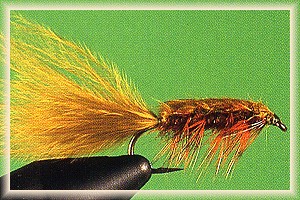Stillwater Nymph
By Philip Rowley
Denny Rickards is an outstanding still-water
angler. Based in Fort Klamath Falls, Oregon,
Denny is owner/operator of Crystal Creek
Guiding Service. He splits his time between
guiding and providing seminars and demonstrations
throughout the Western United States and Canada.
Denny is a popular speaker and fly tier at the
International Sportsman's Expositions held
throughout the western states. During his 30
years fly fishing for stillwater trout, Denny
has compiled a wealth of knowledge. Denny has
just completed his first book, Fly Fishing
Stillwaters For Trophy Trout, and two videos,
one sharing the title of his book, the other,
.
Denny is not a proponent of direct imitation
but prefers to use his suggestive patterns
coupled with a variety of different retrieves
and depths to imitate the varied menu of
stillwater trout. Denny uses only five fly
patterns for his entire stillwater fly fishing.
The Stillwater Nymph is one of these five and
one of his favorites. Denny developed the
Stillwater Nymph over ten years ago while
fishing Diamond Lake in southeastern Oregon.
Well aware that damsel fly nymphs and scuds
are important items on the trout's menu, Denny
set about developing a fly to simulate both
food sources at once.
Denny began by tying in a sparse tail of
olive marabou. Marabou provided the life
and movement that are critical components
to many successful stillwater patterns.
Once tied in, Denny folds the marabou butts
back over the tail (the marabou butts form
the shellback later on). Next he ties in a
grizzly hackle dyed orange to suggest the
brood pouch of a scud. Denny has these
grizzly hackles dyed for him by Jay Fair
from Eagle Eake, California. Jay offers a
full line of quality dyed grizzly hackles,
both in full capes and individually-sized
packages. Denny stresses the importance of
tying the hackle feather in by the tip so
the pattern does not spin during the retrieve.
Wind the hackle a maximum of four turns to
suggest segmentation. Tie in a rib of fine
copper wire to provide added durability,
segmentation and sparkle. Dubbed seal's fur
forms the body. However, seal's fur is not
always readily available. As an alternative
J. Fair offers a product called "Dub-It" that
is a great substitute. Dub-It is an African
goat mix available in a spectrum of
colors that blend well. With the body
complete, bring the marabou butts over
the top of the body to form the shellback.
Trimming the hackle along the top and sides
of the pattern provides the finishing touch.
Denny uses intermediate lines for 90 percent
of his stillwater fly fishing. His favorite
retrieves include the handtwist, a slow 2- to
4-inch pull or a short and rapid 1- to 2-inch
strip. Expect aggressive takes with the short
rapid retrieve. Denny feels the speed of the
pattern is important to the success of any
presentation. The stillwater nymph has proven
to be a great summer pattern in many waters
throughout the western United States and Canada.
Use it throughout the entire fishing season.
Materials: Stillwater Nymph
Hook: Mustad Signature R72.
Thread: Olive 6/0 or 8/0.
Tail: Marabou.
Shellback: Marabou butts from tail material.
Rib: Fine copper wire.
Hackle: Grizzly hackle dyed orange.
Body: Seal's fur or substitute.
Tying Instructions: Stillwater Nymph
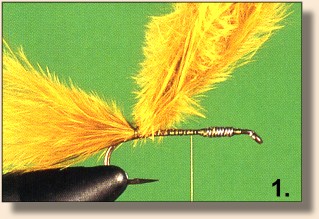
1. Place a debarbed hook into the vise and
weight if desired. Secure weight in place
with tying thread. Strip a sparse clump of
marabou fibers from the stem. Tie in at the
rear of the hook so the marabou is shank
length. Once marabou is secure double the
remaining butt material back over the tail
and secure in place with the tying thread.
These butts will form the shellback later.
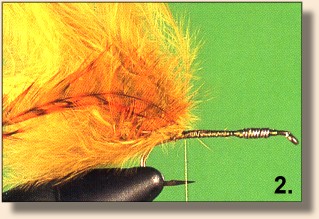
2. Tie in a dyed orange grizzly hackle
by the tip followed by a length of fine
copper wire.
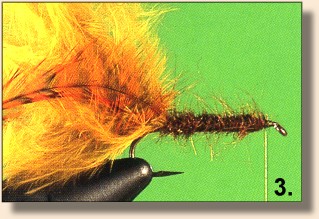
3. Dub a neat body.
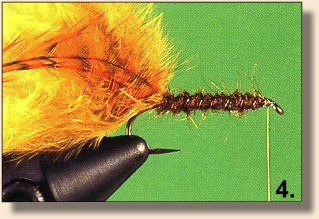
4. Wind the copper rib forward, tie off and break excess.
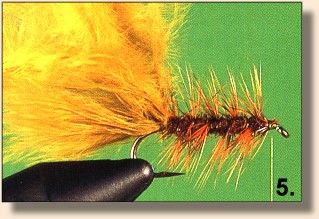
5. Palmer the hackle forward over the body
a max of four times. The hackle simulates
the brood pouch of the nant shrimp and provides
segmentation. Tie off and trir excess saddle feather.
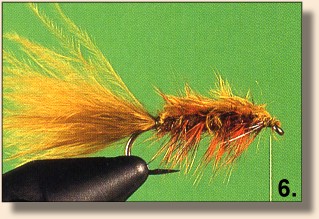
6. Pull the marabou butts over the top of
the fly to the shellback. Tie off and remove
the excess material.
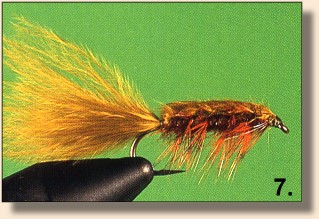
7. Build a neat head and whip-finish. Apply head cement.
Trim the saddle fibers along each side of the fly so that only
lower portions of the hackle remain. ~ PR
Credits: Excerpt from Fly Patterns
for Stillwaters By Philip Rowley, published
by Frank Amato Publications. We appreciate use
permission.
|

